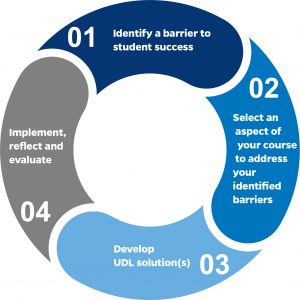UDL focuses on creating an inclusive learning environment in which all learners can succeed. To help you achieve this goal, there are divisional ambassadors who are ready to work with you. Additionally, the following framework may be helpful to you when thinking about integrating UDL into your course(s):
-
01. Identify a barrier to student success
In designing or reflecting on a course and its facilitation, are there areas where some learners might struggle or not have an equal opportunity to effectively demonstrate their knowledge? Are there specific lessons, assessments, or activities that could be enhanced or modified to address these barriers to student success? Note three or four of these areas in which you could reach more learners.
-
02. Select an aspect of your course to address your identified barrier(s)
From your list of areas in which you could reach more learners by alleviating barriers, select at least one that you will improve by embracing UDL.
Consider an area where you could make the most impact. Addressing this area first will likely show a measurable, positive effect on the success of all students as well as motivate you to continue your implementation of UDL.
Additionally, think about what resources and time you have available and if your plan is feasible.
-
03. Develop UDL solution(s)
Developing UDL solutions may seem challenging as there is not necessarily one right answer. To assist in getting started, the Hopkins Universal Design for Learning (HUDL) Initiative has identified four areas that might align with common areas that have the most impact for your learners:
- Creating learning objectives that are aligned to assessments
- Creating diverse assessment strategies – both formative and summative
- Representing content in a variety of formats
- Incorporating active learning into learning experiences
To get started, select one of these areas of focus and consider how it might be applied to your course.
Development
When developing your solution, think about the subject, your learner… and you!
Remember that the content and academic rigor should not suffer, and that if certain information or activities/assessments need to be completed to demonstrate competency, you should not necessarily change or eliminate them.
Instead, you should think about the core knowledge or concept that needs to be relayed or demonstrated and then look at how you may be able to offer variety and options to your students in terms of engagement, representation, and/or action and expression (e.g., the three main UDL principles). (See example below)As you develop your solution, make sure you are offering enough options/ variety to create an inclusive environment for your learners. Additionally, consider the time, resources, and potential costs involved in implementation; if you find yourself overwhelmed, perhaps some adjustments can be made or the ideas can be saved for a future term.
Example –
“Maintaining Content and Rigor While Offering Variety and Options”If you are teaching a public relations course and students must demonstrate that they can write a press release (and students often struggle with this), you probably do not want to offer them the option to choose another format for this assessment (e.g., podcast or presentation) since the objective is to write a press release. Instead, you may want to try to offer options for learning how to write a press release, such as a recorded presentation with captions and transcript, example press release, a textbook chapter on the subject, and/or one or more web articles or resources. You might also create a formative assessment before the final summative assessment in which learners have to locate three press releases and compare and contrast them, explaining positive and negative aspects of each. This allows you to potentially reach more learners and provide options for learning about press releases and their structure without actually changing the format of the assessment itself. This implementation of UDL is an example of creating diverse assessment strategies, one of the HUDL areas of focus.
-
04. Implement, reflect and evaluate
When the time arrives, implement your solutions as you deliver your course to your students.
Pay close attention to determine how your newly developed solution is working, and the effects it is having on your students, the course as a whole, and you.
After you have delivered the lesson and/or the whole course, take time to reflect and evaluate the impact of your changes.
Think about:
- What went well? What didn’t?
- How did students respond? Were they receptive or resistant to the changes you made?
- Did student engagement, performance, and/or persistence increase after you embraced UDL in the activity or resource(s)? Do you believe UDL helped foster your students’ success? If so, how?
- How do you feel about the process embracing the UDL framework?
- How might you further modify the selected activity or resource with UDL? How might you apply your methods to another area in your course?
Midterm and final course surveys and evaluations can be used in your reflection. When available, compare overall performance and satisfaction data from “before UDL” to “after UDL.” If there are open-ended questions, read through student comments to find evidence related to your UDL integration. If you have the opportunity to edit the survey/evaluation, consider asking a question directly related to your UDL solutions.
Review your reflections and evaluation data/information to determine if your new UDL solution(s) are good to go for continued use or if they need adjustments.
Take the opportunity to modify and make improvements. Remember, UDL is a journey and it may take some time to refine your solution(s) and get them just right for your students, your course, and you!
After reflecting and evaluating, you can begin the integration framework again, using your reflections and evaluation data to inform your plan to proceed with future UDL integration in your course(s).
Integrating UDL is a process of continuous improvement. We encourage you to reach out to staff in your division’s teaching and learning center and work with them to continue refining your course.
Resources & Examples
Resources
- Quick Tips [PDF]
- Need help? Reach out to your division’s teaching and learning center.
Examples
- To see some examples of UDL principles in practice at Hopkins, please visit our Exemplars page.
- CAST UDL on Campus: Examples in Higher Education

